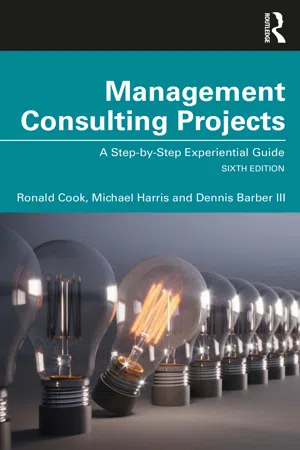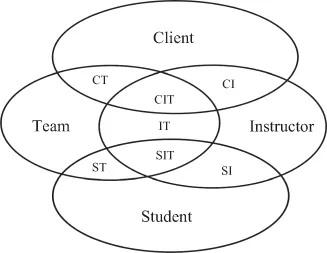
Management Consulting Projects
A Step-by-Step Experiential Guide
- 160 pages
- English
- ePUB (mobile friendly)
- Available on iOS & Android
Management Consulting Projects
A Step-by-Step Experiential Guide
About this book
This textbook provides students with an easy to use, proven roadmap for completing a successful consulting project from start to finish.
Primarily designed for students who work as outside consultants on solving client problems and investigating potential opportunities, the textbook's structure first explains the consulting process to students and then depicts it in a chronological flow, using real-life examples to demonstrate practical application. Each section builds upon the previous one, focusing on the development of critical thinking, problem solving, and communication skills for employability. Now in its sixth edition, this text has been fully revised to bring it up to date with the current business context and global environment, including:
- A major expansion of the tools and resources needed for students to conduct research on a client's situation.
- A new final chapter that ties the overarching consulting process together and focuses on how the student should use this experience for their own professional development.
- New examples of award-winning projects to provide practical guidance.
- Fresh material on the use of new technologies in the consulting process, ethics and data management, and remote working.
This well-renowned model promotes a conceptual understanding of the consulting process and the interactions between and among students, the team, the client, and the instructor. Management Consulting Projects should be essential reading for experiential Business Consulting modules, Small Business Management, and Strategic Management at postgraduate and MBA level.
Frequently asked questions
- Essential is ideal for learners and professionals who enjoy exploring a wide range of subjects. Access the Essential Library with 800,000+ trusted titles and best-sellers across business, personal growth, and the humanities. Includes unlimited reading time and Standard Read Aloud voice.
- Complete: Perfect for advanced learners and researchers needing full, unrestricted access. Unlock 1.4M+ books across hundreds of subjects, including academic and specialized titles. The Complete Plan also includes advanced features like Premium Read Aloud and Research Assistant.
Please note we cannot support devices running on iOS 13 and Android 7 or earlier. Learn more about using the app.
Information
1 Experiential learning using consulting
Abstract
In this chapter, you will find a definition of experiential student team consulting, a discussion of the importance of experiential learning, an explanation of the different types of consulting, a conceptual framework, the purpose of fieldwork, and considerations of confidentiality and ethics.
Definition
Types of consultants
Process consultants encourage their clients to identify their own problems and formulate their own solutions through a series of questions and guidance…. A content consultant is more like a surgeon, in that they take a direct approach to diagnose the problem and develop a corrective action…. The consultant performs all phases of the process, and presents a preferred solution to the client…. A diagnostic approach identifies the causes of problems and recommends a course of action to solve the problem. However, this process stops short at this point and does not see the recommended changes through to fruition. The implementation approach includes the actual execution of the proposed changes.
Experiential learning
- - the learner must be willing to be actively involved in the experience;
- - the learner must possess and use analytical skills to conceptualize the experience;
- - the learner must possess decision-making and problem-solving skills to use the new ideas gained from the experience; and,
- - the learner must be able to reflect on the experience (p. 654).
in the workplace, problems are ill structured, ambiguous, messy, complex, and most often do not have one correct answer that can be found at the end of the book in the answer key…. These types of problems provide a powerful learning opportunity…. This new learning paradigm also makes the learning process messy…. No longer is the path to success clear. This paradigm requires that the students first identify what the real problem is, next identify what they know and need to know, and then identify viable solutions through both creative and critical thinking.
seek to balance academic rigor with a practical relevance which furnishes students with a broader and, we argue, richer, educational experience. They address one of the most salient criticisms of business education today – the absence of realistic experience, applied learning, and grounded personal development.
Fieldwork provides an interdisciplinary catalyst to motivate students’ cognitive and affective learning but also as an impetus for skills-oriented learning by providing team tasks that interweave challenges from several disciplines. A well-chosen problem yields a group of team tasks that requires integrated learning rather than fragmented learning. An interdisciplinary approach is realistic because business problems usually cut across typical curricular boundaries. Thus, PBL encourages students to develop implementation skills that mirror those required to meet future challenges that they will face.
Unlike a regular course where we are told to read chapter 6 and answer questions 1–5, the consulting experience required us to consider whether chapter 6 even mattered and if so, which questions were important. More than anything else, we learned to ask good questions.
Conceptual framework

Table of contents
- Cover
- Half Title
- Title Page
- Copyright Page
- Table of Contents
- About the authors
- Preface
- Introduction
- 1 Experiential learning using consulting
- 2 Developing the consulting team and its dynamics
- 3 Identifying the client's issues through root cause analysis
- 4 Client contract development and relationship management
- 5 Project deliverables
- 6 Professional development and conclusion
- Appendix 1: Templates
- Appendix 2: Examples
- References
- Index